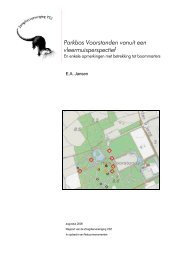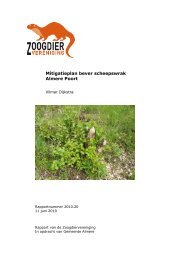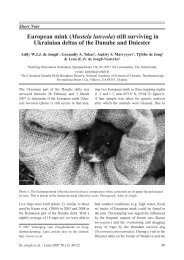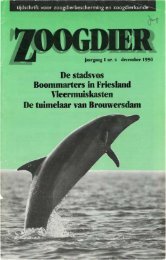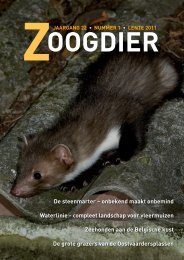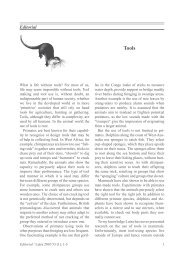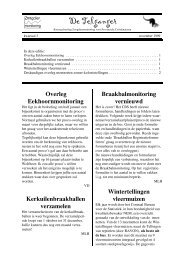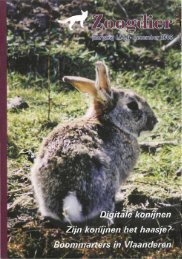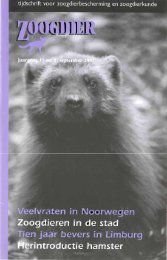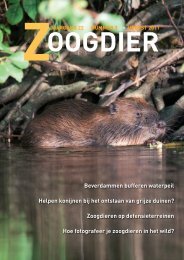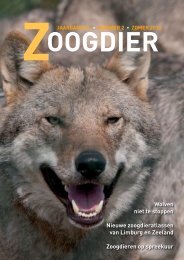binnenwerk 48-2-2005 - De Zoogdiervereniging
binnenwerk 48-2-2005 - De Zoogdiervereniging
binnenwerk 48-2-2005 - De Zoogdiervereniging
Create successful ePaper yourself
Turn your PDF publications into a flip-book with our unique Google optimized e-Paper software.
Bennet & van Olivier (1822) wrote (all citationsin the original Dutch) “Gelijk er voldoenderedenen zijn, om de ware kat onder de voormaligeNederlandsche dieren te kunnen rekenen,zoo meent men op goede gronden dezelve thansals uit Nederland verjaagd of voor geheel uitgeroeidte moeten houden, ...” [italics by Bennet& van Olivier] (“There are reasons to considerthe wildcat to be a former part of the Dutch nativefauna, and it is generally thought that thespecies has been extirpated from the Netherlands.”).Schlegel (1862) mentions that there isno evidence “dat de wilde Kat in vroegere tijdenhier te lande geleefd heeft; ofschoon dit niet onwaarschijnlijkis, daar zij nog heden in hetnaburige Duitschland, en in het Ardenner woudzelfs vrij algemeen voorkomt.” (“... that thewildcat actually lived in the Netherlands, althoughits present occurrence in neighbouringGermany is not improbable, while the speciesmay even be common in the Ardennes.”) And,next, quoting Van Bemmelen (1864), the wildcathas “bijna zeker in vorige eeuwen […] ons landbewoond, hoewel [hem] gene bepaalde opgavenbekend zijn. <strong>De</strong> berigten van het schieten vanwilde Katten, die men zelfs nu nog enkele malenin nieuwsbladen vermeld vindt, betreffen verwilderde[italics by Van Bemmelen] voorwerpen.”(“... almost certainly lived in our country informer centuries, although records are unknown.Reports on shooting of wildcats, which may stillbe found in newspapers, concern stray animals.”)So, there is nothing new under the sun.The comprehensive Dutch mammal handbookby IJsseling & Scheygrond (1943) does not addany further information on wildcats to the 19thcentury sources. Thissen & Hollander (1996) donot include the wildcat in their review of the statusof mammals in the Netherlands since 1800.Thus we have not been able to identify anyrecords about the occurrence of the wildcat in theNetherlands between Roman times up to 1950.This is an indication that the wildcat did not occurin the Netherlands in post-Roman times. Adifferent approach to the subject, that of undertakinga study on place names associated withwildcats (as has been done for beavers, badgersand otters by Van Wijngaarden (1966) and VanWijngaarden & Van de Peppel (1964, 1970))does not seem very useful because of the confusionthat would be caused by the existence of thedomestic cat. This would make it almost impossibleto attribute a place-name unequivocally to awildcat. Moreover there are cat place-names thathave nothing to do with this animal (L. Brouwer,personal communication).Much has been published on the (pre)historicaloccurrence and disappearance from theNetherlands of other mammal species of interest,like the beaver (Castor fiber), the otter (Lutra lutra),the lynx (Lynx lynx), the wolf (Canis lupus),the brown bear (Ursus arctos), and the wild boar(Sus scrofa) (see: van Wijngaarden 1966, vanWijngaarden & van de Peppel 1970, de Rijk1987, Pelzers 1988, Verhagen 1989, van deVeen & Lardinois 1991, Mulder 1992, Ervynck1993). It is remarkable that wildcat was neverdiscussed in the debate about the (re)introductionof carnivores, such as the wolf and the lynx,in the Netherlands. Some of these species havenow been purposefully re-introduced into theNetherlands.In Germany the remains of wildcats from historicaltimes have been found at excavations andin caves from the Middle Ages, but also from the19th century (Piechocki 1990). Piechocki (1990)mentions that after the Middle Ages, massivedeforestation led to the range of the wildcat inGermany being restricted to wooded hill ranges.More recent records, from Westphalia, theeastern part of the German federal state of Nordrhein-Westfalen,show evidence of the presenceof wildcats in hill ranges, such as the TeutoburgerWald and the Sauerland in the nineteenth and earlytwentieth centuries (Feldmann 1984). In Belgiumthere is evidence that the wildcat was presentafter the Middle Ages; Tack et al. (1993)mention that, in the period 1586-1783, there were64 occasions when wildcats were registered inthe bounty administration for vermin in the viscountcyof Gent, although the wildcat itself hadno bounty on its head. So the wildcat appears tohave survived for much longer in neighbouringcountries that it did in the Netherlands.72 Canters et al. / Lutra <strong>2005</strong> <strong>48</strong> (2): 67-90



